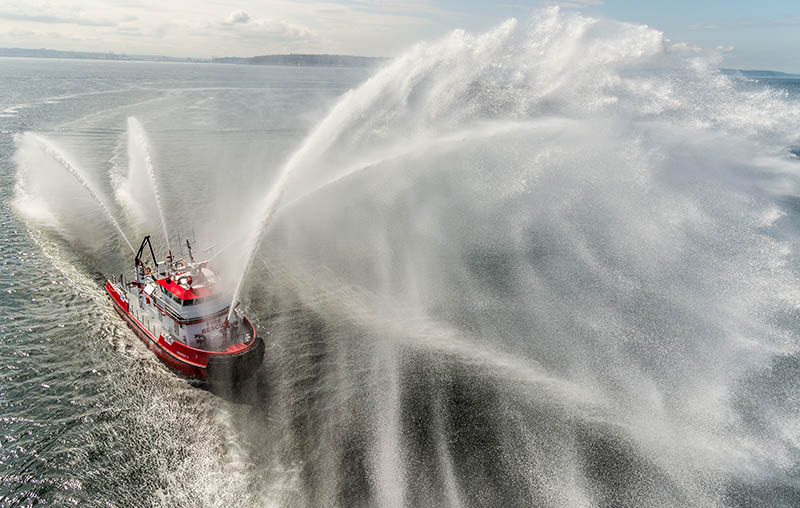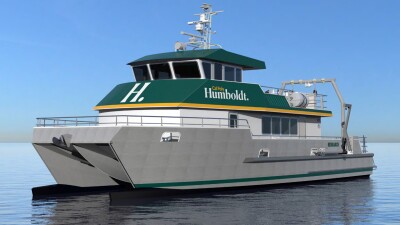The San Francisco Fire Department hasn’t had a new fireboat in more than 60 years — until now. The city officially christened its new 88’x25' fireboat, the Fireboat 3, in mid-October. The boat has an 18,000-gallon-per-minute pumping capacity. (The boat’s name may change, but it was still Fireboat 3 as WorkBoat went to press.) The city has two other fireboats — the Guardian, built in 1951, and the circa-1955 Phoenix. The two boats will stay on the job.
Designed by Jensen Maritime Consultants and built at Vigor’s Seattle shipyard, the $11.8 million, steel-hulled Fireboat 3 is considered a first-in-class vessel.
“We worked with the city for a long time, about two-and-a-half years,” said Johan Sperling, Jensen’s vice president. “First-of-a-class fireboats are tricky. This one’s main function is not the typical fighting fireboat.”
“Because it’s been so long since we’ve built a new boat, none of us had ever done this before,” said Ken Lombardi, assistant deputy chief, SFFD. “We’ve been asking for one every year for many years now, but the problem was always funding.”
That was solved with funding from three different entities — $8 million from a federal port security grant, $3.3 million from the city of San Francisco, and $450,000 from a federal UASI (Urban Areas Security Initiative) grant.
SAFETY NET
While Fireboat 3 will act as any other fireboat in the port of San Francisco, its main function will be as a mobile pumping station for city water, with the ability to plug into the city’s water system should a major earthquake cause a disruption of the system.
“This is not really a fast fireboat. This boat is more about being able to connect to San Francisco’s water system in case of an emergency,” said Keith Whittemore, Vigor’s vice president business development. “We can pump 18,000 gallons per minute into the city’s water system” from various locations.”
Three Cummins QSK19-M, Tier 3 diesel engines, producing 750 hp at 1,800 rpm each, provide propulsion and pumping power.

The Fireboat 3 engine room, where the Cummins main engines take care of propulsion and pumping power. Vigor photo.
“The pumps run off the main engines. The wheels run off the front of the engines and the pumps run off the rear,” said Sperling. “Cummins had never done it that way, configured them that way. It’s a unique thing to have the wheels running off the front. They pulled it off. They did a good job.”
When it comes to pumping, the mains power three Counterfire ESF 300-550 pumps with a capacity of 6,000 gpm each. That’s a total of 18,000 gpm at 150 psi (all three pumps in parallel) or 6,000 gpm at 300 psi (two pumps in series) that flows through six Stang monitors. Power is transmitted to the pumps through three Logan LC318 SAE #0 air actuated clutches and Elbe cardan shafts with Centa Centaflex-R flywheel-mounted torsional coupling. The engines are mounted on Christie & Grey TSC T-10 vibration isolators.
For propulsion from the front of the engine, the two outboard Cummins engines also provide 591 hp at 1,800 rpm. The engines turn 62".55", 4-bladed, CF-3 Sound stainless steel propellers through Centa CX-56 torsional couplings and Karl Senner-supplied Reintjes WAF 364 reduction gears with 4.92:1 reduction ratios. For added maneuverability, the new fireboat has a Wesmar V2-2ONS bowthruster. The new San Francisco fireboat has a running speed of 11.5 knots.
Fireboat 3 is a different kind of animal. “This is the one-off of the one-offs. This boat is absolutely custom built. There is no other fireboat around like this one because of San Francisco’s unique needs,” said Whittemore. “She’s still a firefighter and a patrol boat if needed, but this is a full-blown pumping machine.”

The new fireboat’s main job is to keep the city’s water system flowing in case of a disruption. The boat can pump 18,000 gpm into the system at various locations. Vigor photo.
“It’s really unique. It’s a huge floating pumper,” said Sperling. “The fire department was more concerned with the boat being a provider of water” for city services following an emergency.
As a mobile pumping station, the fireboat can transfer millions of gallons of water directly from the bay into the city’s auxiliary water system for fire.fighting in the streets. “No other city has a water system like ours. We need an auxiliary system in case of a break. That’s what this boat gives us,” said SFFD’s Lombardi. “We’ll never run out of water in the bay.”
A Northern Lights M99C13 genset provides ship’s electrical power, an Aventics Marex OSIII system handles control needs, and a Jastram S-17-2-45 steering system that ensures the boat goes where it is supposed to go.
Fireboat 3’s capacities include 10,900 gals. of fuel; 250 gals. water; 100 gals. lube oil and 1,046 gals. foam concentrate.
The electronics suite includes a variety of Furuno equipment, Nobeltec navigation software, Simrad autopilot and FLIR thermal camera. Though the boat is not officially classed, “the boat is built to class,” said Sperling.
TEAMWORK
It’s rare when a first-of-a-kind boat is delivered on time with no delays. It didn’t happen with Fireboat 3 either. Originally due out in early 2016, the boat was delivered in July. At one point the job’s electrical subcontractor went bankrupt, according to the San Francisco Examiner.
Because the owner, designer, builder and all those associated with the new boat had to approach it as a first of a kind, working closely together wasn’t just lip service. It was a necessity.
“It was a really challenging boat to build, but the fire department, Jensen and all those involved were great to work with,” said Whittemore. “The fact of life with a fireboat is that usually there are lots of systems in a small space. We all knew what was at stake.”
Bureaucratic wheels tend to turn slowly and can impede the progress of a job like this one, even as those same bureaucrats demand the boat be delivered on schedule. “Those guys [SFFD] were great,” said Sperling. “They really knew how to communicate with the bureaucrats to get things done.”
SFFD’s Lombardi said there was a paradox in putting together a state-of-the-art, modern fireboat that wouldn’t be too complex to operate and have minimal maintenance responsibilities.
“We were looking for a modernized boat, but a custom-built boat,” he said. “We wanted to keep it as simple as possible and that would make it more reliable.”
In the end, owner, operator and builder got what each was looking for.
“We got the job based on best value,” said Whittemore. “The relationships you have with the other companies involved can help take some of the pressure off and make the project fun.”
 “You learn something every time you do a project, especially one like this. This was a great, challenging project,” said Sperling. “Every time you finish one, you always think, ‘I’m ready for another one.’ We marine engineers are just like that.”
“You learn something every time you do a project, especially one like this. This was a great, challenging project,” said Sperling. “Every time you finish one, you always think, ‘I’m ready for another one.’ We marine engineers are just like that.”
What’s most important is how the customer feels about the project once it’s completed. “It worked out well for the fire department,” said Lombardi.
Fireboat 3 was christened on Oct. 17, the anniversary of the 1989 San Francisco earthquake. The quake burst the domestic water lines beneath the city. Should this happen again, the new fireboat will ensure that San Francisco has the water it needs to protect its citizens and property.





